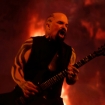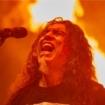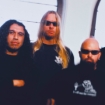No metalhead has gone deeper into the void than Paul F. Thompson. As a navigator for NASA's Jet Propulsion Laboratory (JPL), he's soared past Jupiter with the Juno probe, helped guide the Mars Science Laboratory to its final destination and skipped past far- flung Pluto via the New Horizons spacecraft — much of it while sitting at his desk in Southern California, blasting Slayer and Lamb of God into his headphones.
"People think NASA is pocket protectors and button-up collars and maybe it was in the Apollo days," says Thompson, who spent some college years playing in a metal band and now can usually be found at his post wearing a favorite metal T-shirt, while wrestling with computer code and planetary itineraries. Last year, the space scientist gave Slayer's Kerry King and his wife, Ayesha, a tour of Mission Control. "It's like two separate lives. I have my job and then I have what I do in my free time, which is go to a lot of concerts."
At November's massive Ozzfest Meets Knotfest in San Bernardino, California, Thompson looked like any other goateed metal fanatic on the grass, tall beer in one hand and horns flying high on the other during the groove-metal pummel of Upon a Burning Body. He wasn't planning to enter the mosh pit, but did jump into the swirl during the vintage thrash of Death Angel: "One of my all-time favorite bands. It was important to get into the fray."

"I used to do it more, but I don't bounce back like I used to. Once you get to be my age, you have to worry about ibuprofen and other aids," he says with a laugh, standing beside his wife, Glenna, and wearing a black Motörboat cruise T-shirt. "In my 20s it was fine." Most of his fellow scientists at JPL know little of this side of Thompson's life, and would definitely be surprised to see him in a mosh pit at all, he says. It's the same when friends who only know him as a metal fan discover his day job. "I've known people for years who were shocked by what I do for a living because we connected on music."
When King showed up for his tour, tattooed and wearing a black Metal Mulisha T-shirt, the guitarist walked among the consoles and mood lighting of Mission Control and posed for a picture barking orders into a phone. Thompson told him the story of Jack Parsons, a young rocket scientist and co-founder of JPL, who was a leading proselytizer for occultist Aleister Crowley and hosted boho orgies at a mansion in nearby Pasadena before blowing himself up while mixing chemicals at home in 1952.
A crater was later named for Parsons on the dark side of the moon. "If he was alive today he would probably listen to metal, because he was a party animal," Thompson says. "He was a smart guy, he was a chemist, and he was experimental with his life. It would be tough for him to get a job here now." Thompson now has a snapshot of himself with King taped above his desk at JPL, right next to another picture with renowned physicist Stephen Hawking. The thrash guitarist and his wife were clearly intrigued during their visit, posting Instagram pictures soon after. "I was just surprised that they were as big fans of my work as I was of his work," says Thompson, who was introduced to King through mutual friends. "You just don't realize how many people are looking in to what you do from a day-to-day basis — it's just your job at some level. It's pretty amazing whose paths you cross."
Thompson has preferred his metal fast and aggressive ever since he got his first mind-altering blast of Slayer as a 15-year-old kid in Eureka, California, in 1984. The song was the early thrash cut "Evil Has No Boundaries," and he understood immediately that it was different from the Judas Priest and Van Halen he was listening to then. Somewhere within all that noise and chaos, Thompson says, he heard math.
"It challenged me. I had to stop and pay attention to what was going on," Thompson remembers. "At first, I thought, 'Wow, that's kind of noisy. What's going on in there?' And I had to really listen to it. There were hooks, there were obviously riffs and patterns and thought put into it. It's finding the order within the chaos. It drew me in."
It wasn't the kind of music easily found in Eureka, so his friends traded cassettes of metal brought in from San Francisco. They weren't much interested in the kind of hair-metal bands then dominating MTV. And not everyone tolerated thrash. "It was underground at that time just by its nature," he says. "You knew if you put Metallica or Slayer on, they would leave the room, and we thought that was a good thing."
Thompson found that some of his teenage science friends shared his metal obsessions. "There's plenty of intelligent and academically inclined people that listen to this and appreciate it. It's got more to it than just noise," he says. Like his friends, he was less interested in hard rock that only celebrated skipping school and partying all night and every day.
"As a student, I didn't exactly fit in," he continues. "I had really good grades. I like science and math. When you're a teenager, that's considered a bad thing to spend your time on, at least when I was growing up. You're odd if you enjoy taking a test.
"Ironically, I was drawn to these individuals that were sort of on the fringes — the people that were listening to this type of music, as it turned out. We all bonded with the music and video games. That gave us our own community."

By the time he got to UCLA — for physics as an undergrad, before earning a master's degree there in earth and space sciences — he found more science students who liked to get loud. One of them taught him to play guitar. "Some of the smartest people I knew were into metal," he recalls. "There was complexity in there that attracted us."
He didn't spend a lot of time on the nearby Sunset Strip. "It was still a lot of the hairspray bands at that time," says Thompson, who would instead drive out of L.A. to Orange County and Riverside County to find the hard stuff. Metallica and Slayer were getting big enough to play arenas. "You had to get off the Strip to see some of the stuff we liked."
Before leaving Los Angeles to earn his PhD, in aerospace engineering at the University of Texas at Austin, Thompson played guitar for a few years in a band called Henrod. His hair was down to his chest. The band recorded a four-song EP cassette that included a cover of Black Flag's "Depression." Henrod played some parties, clubs and one memorable show at the Roxy on the Strip. "We didn't get very far, mainly because the drummer ended up in jail for several months. It was a classic drummer tale," he says. "I've had my opportunities to be onstage, and I like it to a point. I am much happier being in front of a stage than on it."
At the same time, he was also a lifelong fanatic for Star Trek, Star Wars and other science fiction and fantasy — his Titanium alloy wedding ring is colored deep blue in tribute to the time-traveling, space-wandering Tardis police booth of Doctor Who. But Thompson hadn't seriously thought of taking his math and science skills to the real space program until late in his education.
"When you're four years old, you say, 'When I grow up, I want to be an astronaut,' or, 'When I grow up, I want to be a scientist.' And when you get older, people convince you that you shouldn't dream like that. You should do something more practical, like you should become a lawyer or a nurse or something that is down to earth. It wasn't until I was working on my master's degree at UCLA, and said, 'You know, I should look into getting a job at JPL.'"
His first stint at the lab was in 1994–95, as a member of the sequencing team for the Galileo spacecraft during its mission at Jupiter, when he realized, "It wasn't this dream that I should give up." He only left JPL to earn his PhD in Texas, but returned in 2005, and he's remained ever since, working on nearly a dozen missions.
Thompson is currently working as navigation team chief on the Parker Solar Probe, which is set to come closer to the sun than any previous spacecraft to study the solar environment: all the protons and electrons, the charged particles and magnetic fields. The launch date from Kennedy Space Center in Florida is six months away.
"It's a sprint to the finish, to be honest," he says, sitting beside a whiteboard covered in numbers with dots and lines suggesting upward motion. It's a rough diagram scrawled during a meeting to help visualize the coming launch. "We had spreadsheets full of numbers. People were doing math in their heads ... If you can't visualize it, it's difficult to explain it to somebody else. The math only goes so far."

As a navigator, Thompson typically goes from mission to mission as needed. Sometime after the landing, he noticed when a different scientist woke up Curiosity one Martian morning from JPL with the Anthrax song "Got the Time." He never found out who it was. There are, after all, about 5,000 people at the lab, he explains. "I laughed. That's awesome that somebody snuck that in," says Thompson, who heard about it on Facebook. "We're all just closet fans. We don't think there's any crossover so we keep it to ourselves."
On a shelf in his office is a Lego space shuttle still in the box, and the reference book Fundamentals of Astrodynamics and Applications is within reach on his desk. Thompson has begun covering his walls with artwork commemorating JPL missions, including planets and moons across the solar system known to have water in the form of liquid or ice. (Also in his office, and waiting to be hung, is a poster for Metallica's show at the neighboring Rose Bowl stadium.)
In 2012, he was on the team that successfully completed the high-anxiety mission of landing the Mars Science Lab rover Curiosity on the surface of the planet, after a trip of 352 million miles. There would be no second try, and the vast distance meant JPL would have to wait 14 minutes to get a signal confirming a safe landing or something worse. "We practiced that for months. We practiced so many things that can go wrong," he remembers. "Everything went right. It was better and less tense than any of the dress rehearsals. That's pretty common. We test things so often that on the actual event, personally, I tend to be more calm."
Back in 1977, Thompson's interest in the cosmos was inflamed as a child by the launch of two Voyager probes, which embarked on a grand tour of the solar system, passing by Jupiter, Saturn, Uranus, Neptune and their accompanying moons. His discovery of heavy metal was still years away, but the twin probes each famously contained golden phonograph records with sounds from earth. On that album were spoken greetings, whale songs, classical, jazz and folk recordings, and one rock song: Chuck Berry's "Johnny B. Goode." Now, at JPL, space exploration is inching toward taking metal — and metalheads — out into the solar system.
If he had a chance to send a new golden disc into space, and to share his metal obsession with the universe, Thompson says he'd have to give that mission some thought. "You've got to put some math rock on there," he says, mentioning the prog-metal band Between the Buried and Me. He then turns to the complex, bruising sounds of a favorite Swedish act. "I'd have to put Meshuggah on there for sure. You're sending it out into space. Make it a little complicated.
"From a music standpoint, it's a challenge for the ear. For my job, it's a challenge for my mind. If it's too simple, if it's too obvious, I get bored."












